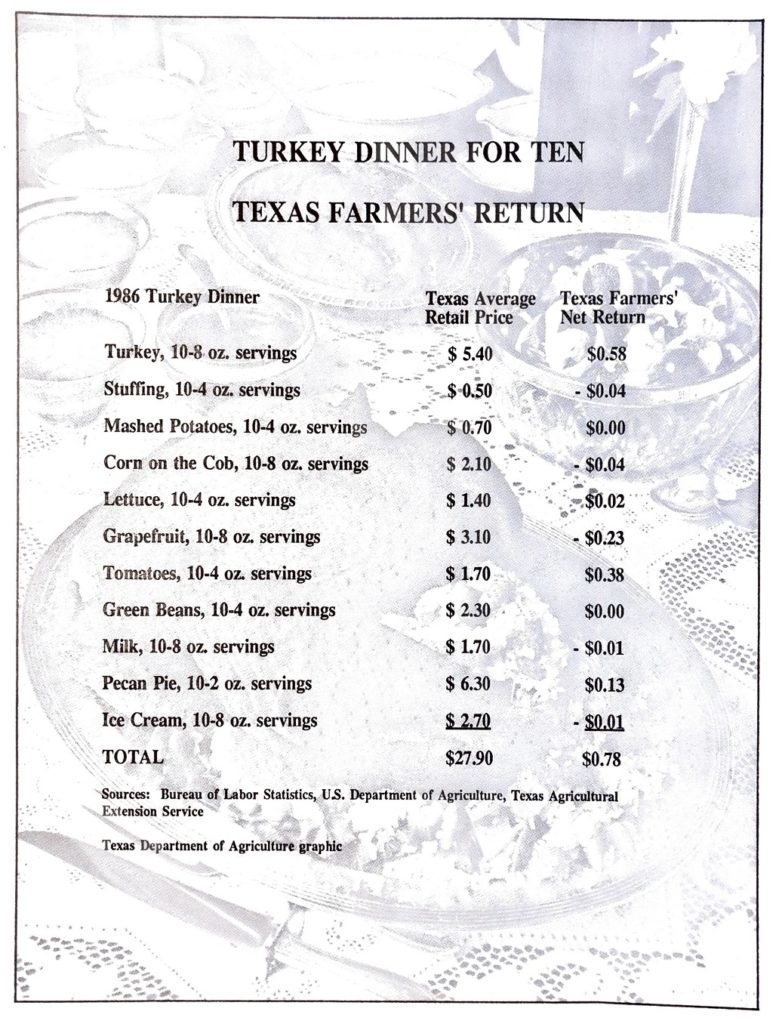Turkey Day Economics
The news from the Farm Bureau is that cost of Thanksgiving dinner is up 14% to a whopping $53.31. Of course that $53 is enough turkey and sweet potatoes and pie to feed 10 people. So… about $5 a plate. I personally have never paid that much for a latte, but I know people who have. So, it’s a pretty good deal for America. The question is whether it is a good deal for farmers. And the answer is…not so much.
The total cost of a traditional Thanksgiving dinner is up 14% from last year. Amid the national concern about inflation, folks might think the farmers are cashing in.
PHIT would like to put that into context for you.
News flash. Corporate farmers and corporate retailers are cashing in. Farmers are receiving a diminishing amount of the total cash flow.
Of that total turkey dinner bill of $53.31, only 14 cents per dollar goes to the farmers based on calculations from the Farmer’s Union, an organization that is an advocate for the family farmer. The Farm Bureau, the more conservative of the two national organizations, tends to be more focused on corporate farming.
Heather Ball, while working for Jim Hightower at the Texas Department of Texas in the 1980s, and at the direct request of Jim Hightower, was the first to begin estimating the amount of the Thanksgiving dollar that went to the actual living farmer.

Says Ms. Ball, “I started calculating the farmer’s share of Thanksgiving Dinner in 1984. Back then, the average farmer received just 26 cents of every consumer food dollar. By 1990, that amount had declined to 24 cents, while consumers were paying 76 additional cents for all the packaging. processing advertising and monopoly pricing markup. Even in 1990, one company controlled 70-80 percent of turkey production in the state. Hightower wanted to demonstrate to John Q. Citizen, in a dramatic way, just why the farmers are going broke when everything costs so much at the grocery store.
“Today, the National Farmers Union has carried on this tradition. According to their calculations, the amount of a consumer’s food dollar going to farmers and ranchers is just 14.3 cents. But consumers are paying more for their Thanksgiving dinner. According to the Farm Bureau’s 36th annual Thanksgiving survey, the average cost of this year’s classic Thanksgiving dinner for 10 is $53.31. This is a $6.41, or 14 percent, increase from last year’s average of $46.90.”
Please note that in 1950, the percentage of the Thanksgiving dollar that went to the farmer was 50 cents on the dollar. It is now 14 cents. The TDA in the 1980s was trying to reverse that trend by proposing programs to reverse the trend and help the family farmer.
Heather Ball had a quick summary of what theThe Texas Department of Agriculture under Hightower recommended for consumers:
“1) Purchase fresh fruits and vegetables. The farmer gets more of the total price. The price “spread” between what the farmer receives and what the consumer pays in the store is generally lower than it is for canned or frozen products.
2) Buy from local producers, either at your grocery store, Consumer Supported Agriculture group, food coop or ordering directly from your favorite farmer or rancher.
3) Shop at farmers’ markets. Almost non-existent when Hightower took office in 1982, there were over 125 across the state by 1990. That number has remained relatively constant, despite lack of support from subsequent Texas Commissioners of Agriculture.”
Watch this blog and this website for continuing interviews with participants in the TDA Camelot Legacy.